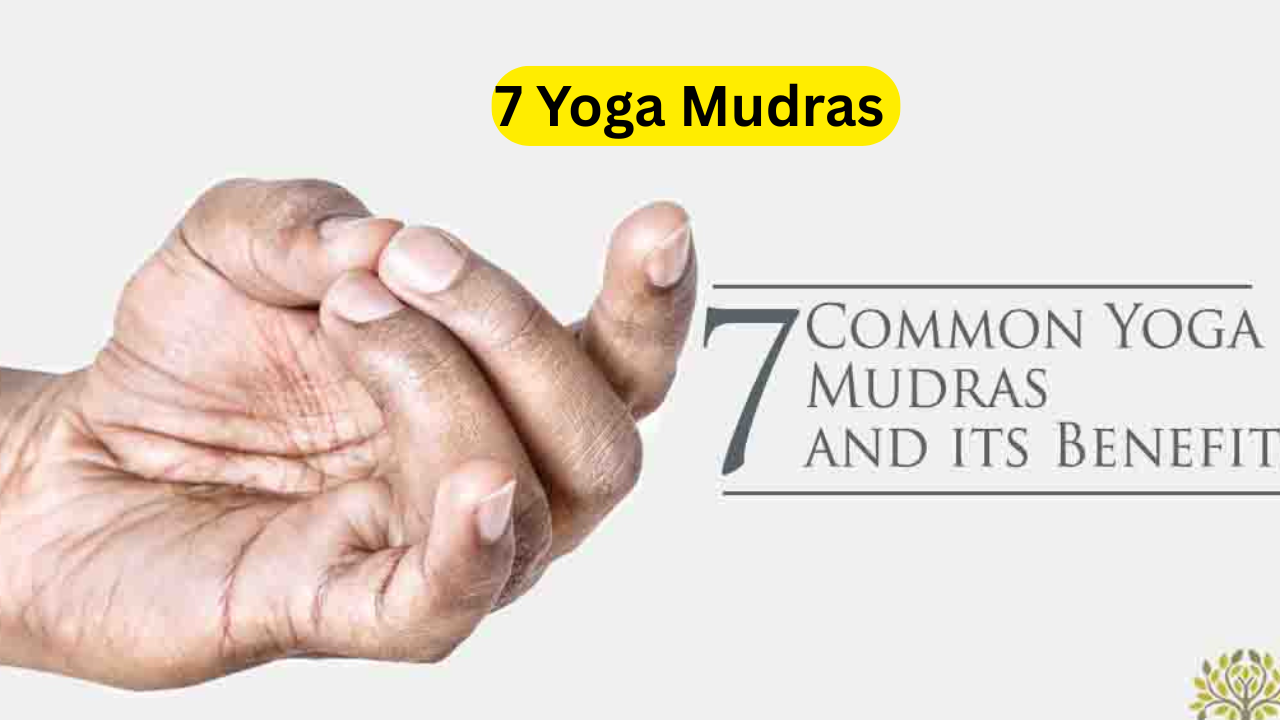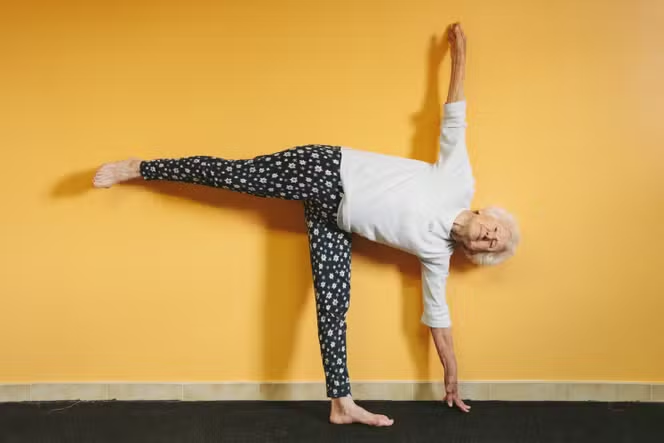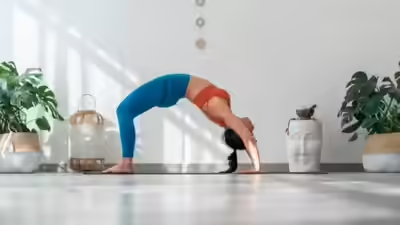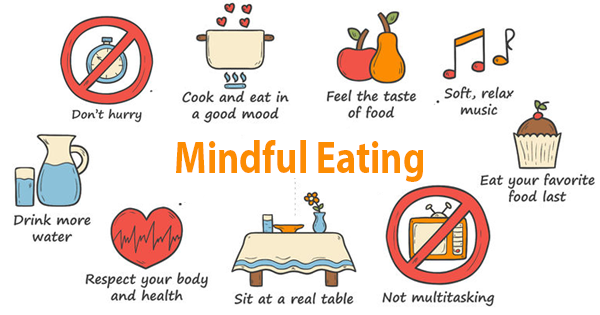7 Yoga Mudras: Yoga is not only about physical postures and breathing techniques but also involves subtle practices like mudras—symbolic hand gestures that channel energy within the body. These ancient techniques, rooted in the science of Ayurveda and yogic philosophy, have been practiced for centuries to promote physical, mental, and spiritual well-being. Known as “yoga in your hands,” mudras are easy to practice and highly effective when combined with meditation or pranayama (breath control).
Each yoga mudra stimulates specific energy channels and elements in the body, supporting internal balance and harmony. The fingers represent five elements—fire (thumb), air (index), space (middle), earth (ring), and water (little finger). By touching or pressing the fingers in specific ways, these elements can be activated or suppressed to heal the body and mind. Regular practice can lead to significant improvements in health—boosting immunity, reducing stress, increasing energy, and enhancing mental clarity.
In today’s fast-paced lifestyle, incorporating mudras into your daily routine can be a game-changer. You don’t need any special equipment, clothing, or space. Just a few minutes a day can make a profound difference in how you feel and function. Whether you’re dealing with stress, fatigue, skin issues, or digestion problems, these seven yoga mudras can help you regain balance and vitality.
What Are Yoga Mudras?
Yoga mudras are hand gestures used during meditation, pranayama, or yoga to direct the body’s energy flow. They work by stimulating different parts of the body and mind, bringing about a state of inner peace and healing. Mudras are deeply connected to the nervous system and subtle energy channels (nadis), helping activate dormant energy centers and chakras.
1. Gyan Mudra – Mudra of Knowledge
How to Do It:
Touch the tip of the index finger to the tip of the thumb while keeping the other three fingers extended and relaxed.
Benefits:
- Enhances concentration, memory, and creativity
- Reduces stress, anxiety, and mental fatigue
- Helps achieve mental clarity and spiritual awareness
- Commonly practiced during meditation and pranayama
2. Prana Mudra – Mudra of Life Energy
How to Do It:
Touch the tips of the ring finger and little finger to the tip of the thumb. Keep the other fingers straight.
Benefits:
- Activates the root chakra (Muladhara), energizing the body
- Boosts immunity and fights chronic fatigue
- Improves eyesight and mental alertness
- Supports the body’s natural healing process
3. Vayu Mudra – Mudra of Air
How to Do It:
Fold the index finger and press it lightly with the thumb at the base. The rest of the fingers remain straight.
Benefits:
- Balances the air element in the body
- Provides relief from joint pain, arthritis, and gout
- Calms nervous energy, promoting emotional balance
- Useful for people with Parkinson’s or tremors
4. Shunya Mudra – Mudra of Emptiness
How to Do It:
Fold the middle finger and press it down with the thumb at its base. Keep the remaining fingers extended.
Benefits:
- Balances the space element in the body
- Alleviates ear pain, vertigo, and hearing problems
- Enhances intuition and spiritual receptivity
- Reduces mental dullness and confusion
5. Apana Mudra – Mudra of Digestion and Detoxification
How to Do It:
Touch the tips of the middle and ring fingers to the tip of the thumb. The other fingers remain extended.
Benefits:
- Regulates the excretory system and supports detox
- Relieves constipation, diabetes, and urinary disorders
- Promotes a sense of grounding and patience
- Stimulates the downward flow of energy (Apana Vayu)
6. Prithvi Mudra – Mudra of Earth
How to Do It:
Touch the tip of the ring finger to the tip of the thumb. Keep the other fingers straight.
Benefits:
- Increases the earth element, promoting strength and stability
- Improves skin tone, hair growth, and nail health
- Enhances physical endurance and stamina
- Supports tissue repair and healing
7. Varun Mudra – Mudra of Water
How to Do It:
Lightly touch the tip of the little finger to the tip of the thumb. The rest of the fingers stay relaxed.
Benefits:
- Balances the water element, supporting hydration
- Prevents dry skin, improving skin elasticity and glow
- Enhances circulation and blood pressure regulation
- Reduces nervousness and emotional imbalance
How to Practice Yoga Mudras
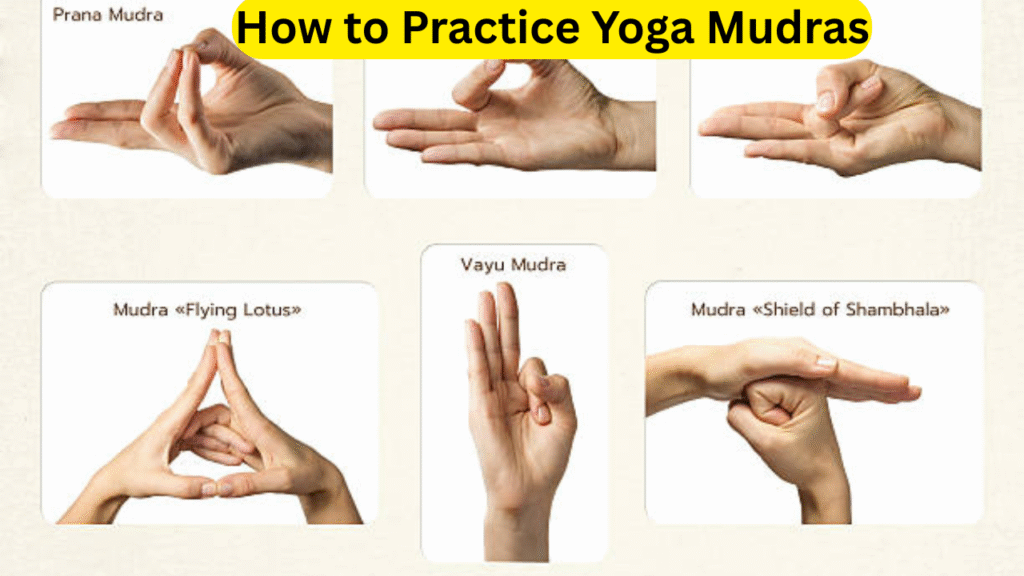
- Practice mudras while sitting in a comfortable meditative posture like Padmasana or Sukhasana.
- Hold each mudra for 15–30 minutes daily or in 3 sets of 10 minutes each.
- Best practiced during early morning hours or in a peaceful environment.
- Combine mudras with slow, deep breathing or pranayama for best results.
- Avoid practice right after meals or when extremely tired.
Also Read: 11 Yoga Poses for Strong Legs: A Complete Guide for Flexibility and Strength
7 Yoga Mudras Conclusion
Yoga mudras offer a simple yet profound way to restore balance, health, and harmony in your life. These subtle hand gestures activate your body’s internal energy system, working on a deep level to enhance immunity, mental clarity, and emotional resilience. Unlike other forms of exercise, mudras require minimal effort but deliver lasting results when practiced consistently.
The beauty of mudras lies in their accessibility—anyone, regardless of age or physical condition, can practice them. Whether you’re battling chronic ailments or simply seeking peace of mind, incorporating these seven mudras into your daily routine can help you align your body, mind, and spirit.
Consistency is key. The more regularly you practice, the more you’ll experience tangible results—from improved sleep and digestion to a calmer, more focused mind. The effects may seem subtle at first, but over time, the transformation can be profound.
It’s also essential to remain mindful and patient. Yoga mudras are not quick fixes but long-term companions on your wellness journey. Respect their ancient wisdom and approach them with sincerity and discipline.
In a world full of stress and imbalance, these ancient gestures serve as gentle reminders to reconnect with your inner self and the elements of nature. Begin your mudra journey today, and experience the ripple effect of calm, health, and harmony in every aspect of your life.
7 Yoga Mudras FAQs
1. What are yoga mudras and how do they work?
Yoga mudras are symbolic hand gestures used in yoga and meditation to direct energy flow in the body. Each finger represents a different element (fire, air, space, earth, water). By pressing or connecting fingers in specific ways, we can influence these elements to balance internal systems, promote healing, and support emotional and mental clarity.
2. How long should I hold a yoga mudra for best results?
For effective results, a mudra should be practiced for 15–30 minutes daily. You can also break this into three 10-minute sessions. Some benefits may appear immediately (like stress relief), while deeper healing (like improved digestion or immunity) requires regular, long-term practice.
3. Can anyone practice yoga mudras?
Yes, yoga mudras are safe and suitable for people of all ages and fitness levels. They are especially helpful for those who may have limited mobility or health conditions that restrict physical yoga practice. However, if you have a severe medical condition, it’s best to consult a healthcare provider before starting any new wellness practice.
4. Can I do yoga mudras after eating or before sleeping?
It is recommended to practice yoga mudras on an empty stomach or at least one hour after a light meal. Some mudras, like Varun Mudra or Gyan Mudra, can be done before sleep to promote relaxation, while others like Apana Mudra are best done during the day for detox benefits.
5. Do mudras have any side effects?
When practiced correctly, yoga mudras do not have negative side effects. However, overdoing any mudra or using the wrong mudra for your condition may lead to imbalances. It’s important to understand the purpose and practice duration of each mudra. Listening to your body and consulting an experienced yoga practitioner can help avoid any discomfort.
